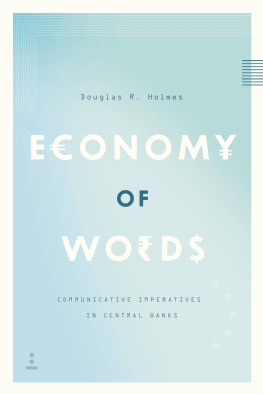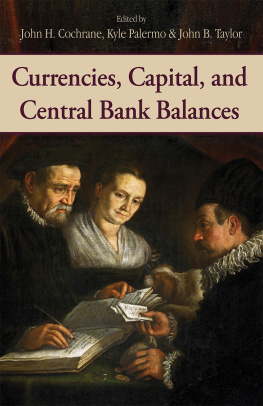Central Bank Governance and Oversight Reform

The Hoover Institution gratefully acknowledges the following individuals and foundations for their significant support of the Working Group on Economic Policy and this publication:
Lynde and Harry Bradley Foundation
Preston and Carolyn Butcher
Stephen and Sarah Page Herrick
Michael and Rosalind Keiser
Koret Foundation
William E. Simon Foundation
John A. Gunn and Cynthia Fry Gunn
Central Bank Governance and Oversight Reform
EDITED BY
John H. Cochrane
John B. Taylor
CONTRIBUTING AUTHORS
Michael D. Bordo
Alex Nikolsko-Rzhevskyy
David H. Papell
Charles I. Plosser
Ruxandra Prodan
George P. Shultz
Paul Tucker
Carl E. Walsh
Kevin M. Warsh
John C. Williams
HOOVER INSTITUTION PRESS
STANFORD UNIVERSITY
STANFORD, CALIFORNIA

With its eminent scholars and world-renowned library and archives, the Hoover Institution seeks to improve the human condition by advancing ideas that promote economic opportunity and prosperity, while securing and safeguarding peace for America and all mankind. The views expressed in its publications are entirely those of the authors and do not necessarily reflect the views of the staff, officers, or Board of Overseers of the Hoover Institution.
www.hoover.org
Hoover Institution Press Publication No. 666
Hoover Institution at Leland Stanford Junior University,
Stanford, California 94305-6003
Copyright 2016 by the Board of Trustees of the Leland Stanford Junior University
All rights reserved. No part of this publication may be reproduced, stored in a retrieval system, or transmitted in any form or by any means, electronic, mechanical, photocopying, recording, or otherwise, without written permission of the publisher and copyright holders.
For permission to reuse material from Central Bank Governance and Oversight Reform, ISBN 978-0-8179-1924-5, please access www.copyright.com or contact the Copyright Clearance Center, Inc. (CCC), 222 Rosewood Drive, Danvers, MA 01923, 978-750-8400. CCC is a not-for-profit organization that provides licenses and registration for a variety of uses.
Efforts have been made to locate original sources, determine the current rights holders, and, if needed, obtain reproduction permissions. On verification of any such claims to rights in the articles reproduced in this book, any required corrections or clarifications will be made in subsequent printings/editions.
Hoover Institution Press assumes no responsibility for the persistence or accuracy of URLs for external or third-party Internet websites referred to in this publication, and does not guarantee that any content on such websites is, or will remain, accurate or appropriate.
Cataloging-in-Publication Data is available from the Library of Congress.
ISBN-13: 978-0-8179-1924-5 (cloth. : alk. paper)
ISBN-13: 978-0-8179-1926-9 (epub)
ISBN-13: 978-0-8179-1927-6 (mobi)
ISBN-13: 978-0-8179-1928-3 (PDF)
Contents
John H. Cochrane and John B. Taylor
Paul Tucker
: John H. Cochrane
: Michael D. Bordo, John H. Cochrane, Peter Fisher, Robert Hodrick, Charles I. Plosser, George P. Shultz, John B. Taylor, Paul Tucker, Kevin M. Warsh
David H. Papell, Alex Nikolsko-Rzhevskyy and Ruxandra Prodan
: Michael Dotsey
: John H. Cochrane, Michael Dotsey, Peter Fisher, Andrew Levin, David H. Papell, Charle I. Plosser, John B. Taylor, Paul Tucker, Carl E. Walsh, John C. Williams
Carl E. Walsh
: Andrew Levin
: John H. Cochrane, Michael Dotsey, David H. Papell, John B. Taylor, Carl E. Walsh, John C. Williams
Kevin M. Warsh
: Peter Fisher
: Binyamin Appelbaum, Michael D. Bordo, John H. Cochrane, Michael Dotsey, Peter Fisher, Andrew Levin, Charles I. Plosser, George P. Shultz, Paul Tucker, Kevin M. Warsh, John C. Williams
Michael D. Bordo
: Mary H. Karr
: Michael D. Bordo, John H. Cochrane, Peter Fisher, Mary H. Karr, Andrew Levin, Charles I. Plosser, George P. Shultz, John B. Taylor, Paul Tucker, Kevin M. Warsh, John C. Williams
Charles I. Plosser, George P. Shultz, and John C. Williams
: Michael J. Boskin, John H. Cochrane, Peter Fisher, Robert Hodrick, Andrew Levin, David Papell, Charles I. Plosser, John B. Taylor, Paul Tucker, Kevin M. Warsh, John C. Williams
Preface
John H. Cochrane and John B. Taylor
At the time we were organizing this conference, most of the voluminous commentary about the Federal Reserve System centered on what decisions it should take. Should the Fed raise interest rates? How soon? How much?
We thought the conference could make more progress by focusing on a different and deeper set of questions. How should the Fed make decisions? How should the Fed govern its internal decision-making processes? How should Congress, from which the Fed ultimately receives its authority, oversee the Fed? Central bank independence is a great virtue, but independence in a democracy must come with clear limits and a limited scope of action. What should those limits be? What is the trade-off between greater Fed power and less Fed independence? How should Congress manage its fundamental oversight role? Several bills in Congress stipulate more rules-based policy and consequent accountability, along with deeper monetary reforms. Are these bills a good idea? How should they be structured?
The distinguished scholars and policymakers at the conference, whose contributions and commentary are represented in this conference volume, do not disappoint in their analysis of these and related questions.
Paul Tuckers opening paper, How Can Central Banks Deliver Credible Commitment and be Emergency Institutions? leads off with a central conundrum: in general, people seem to want central banks to follow rule-based policy in normal times, but people expect banks to take a much more discretionary do-what-it-takes approach to stopping financial crises. Tucker asks if these two hats can be worn at once. He builds up to the basic conclusion: LOLR [lender of last resort] liquidity reinsurance policy can be systematic, and should be framed within a regime, just as normal-times monetary policy should be so framed.
Tucker starts by thinking through the limits on the central banks tools. Should the central bank, even in a crisis, be legally limited to traditional open market operations, exchanging reserves for short-term treasuries? Or should the central bank be free to purchase many different kinds of assets in crises? He notes the many restrictions, including central bank independence, that stand in the way of inflationary finance in normal times, but which may be inappropriate during crises.
Looking at the modern financial system, Tucker concludes that money, credit, and finance are not separable. He advocates an integrated money-credit constitution consisting of inflation targeting plus a reserves requirement that increased with a banks leverage plus a liquidity-reinsurance regime plus a resolution regime for bankrupt banks plus constraints on how the central bank is free to pursue its mandate.
Next page










